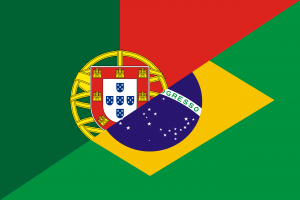Language/Portuguese/Vocabulary/Physical-Descriptions
 Հայերէն
Հայերէն Български език
Български език 官话
官话 官話
官話 Hrvatski jezik
Hrvatski jezik Český jazyk
Český jazyk Nederlands
Nederlands English
English Suomen kieli
Suomen kieli Français
Français Deutsch
Deutsch עברית
עברית हिन्दी
हिन्दी Magyar
Magyar Bahasa Indonesia
Bahasa Indonesia فارسی
فارسی Italiano
Italiano 日本語
日本語 Қазақ тілі
Қазақ тілі 한국어
한국어 Lietuvių kalba
Lietuvių kalba Νέα Ελληνικά
Νέα Ελληνικά Şimali Azərbaycanlılar
Şimali Azərbaycanlılar Język polski
Język polski Limba Română
Limba Română Русский язык
Русский язык Српски
Српски Español
Español العربية القياسية
العربية القياسية Svenska
Svenska Wikang Tagalog
Wikang Tagalog தமிழ்
தமிழ் ภาษาไทย
ภาษาไทย Türkçe
Türkçe Українська мова
Українська мова Urdu
Urdu Tiếng Việt
Tiếng Việt
| ◀️ Family Members — Previous Lesson | Next Lesson — Personality Descriptions ▶️ |
Introduction[edit | edit source]
Welcome to Unit 3 of the "Complete 0 to A1 Portuguese Course"! In this unit, we will focus on the topic of Family and Descriptions. In this particular lesson, we will learn how to describe people's appearances using adjectives and basic vocabulary words. Being able to describe someone's physical characteristics is essential for effective communication and building relationships. So let's dive in and expand our Portuguese vocabulary!
Vocabulary[edit | edit source]
Let's start by learning some useful vocabulary words related to physical descriptions. These words will help us describe people's appearances accurately and in detail. Take a look at the table below:
| Portuguese | Pronunciation | English |
|---|---|---|
| alto(a) | AHL-too(a) | tall |
| baixo(a) | BAH-ee-shoo(a) | short |
| magro(a) | MAH-groo(a) | thin |
| gordo(a) | GOHR-doo(a) | fat |
| bonito(a) | boh-NEE-too(a) | beautiful/handsome |
| feio(a) | FAY-oo(a) | ugly |
| jovem | JOH-vehm | young |
| velho(a) | VEH-lyoo(a) | old |
| cabelo | kah-BEH-loo | hair |
| olhos | OH-yoosh | eyes |
| pele | PEH-leh | skin |
Take your time to practice pronouncing these words correctly. It's important to get the pronunciation right to be easily understood.
Describing Physical Characteristics[edit | edit source]
Now that we have learned some vocabulary words, let's see how we can use them to describe people's physical characteristics. We will use the verb "ser" (to be) to form our sentences. Here are a few examples:
- Ela é alta. (She is tall.)
- Ele é baixo. (He is short.)
- A mulher é magra. (The woman is thin.)
- O homem é gordo. (The man is fat.)
As you can see, we use the verb "ser" followed by the adjectives to describe someone's physical appearance. Remember that adjectives must agree in gender and number with the noun they describe. So if you are describing a man, you would use the masculine form of the adjective, and if you are describing a woman, you would use the feminine form.
Let's practice a bit more. Look at the following examples:
- Ele tem cabelo preto. (He has black hair.)
- Ela tem olhos azuis. (She has blue eyes.)
- Ele tem a pele clara. (He has fair skin.)
- Ela tem cabelo loiro. (She has blonde hair.)
In these examples, we are using the verb "ter" (to have) to talk about specific physical features. Again, pay attention to the agreement between the adjectives and the nouns they describe.
Additional Vocabulary[edit | edit source]
To expand our vocabulary further, let's learn some additional words related to physical descriptions. These words will help us describe people's appearances in even more detail:
- alto(a) e magro(a) - tall and thin
- baixo(a) e gordo(a) - short and fat
- bonito(a) e jovem - beautiful/handsome and young
- feio(a) e velho(a) - ugly and old
- cabelo castanho - brown hair
- cabelo ruivo - red hair
- cabelo grisalho - gray hair
- olhos castanhos - brown eyes
- olhos verdes - green eyes
- olhos pretos - black eyes
- pele bronzeada - tanned skin
- pele morena - dark skin
Feel free to practice using these words in sentences to describe people's appearances in different scenarios.
Conversation Practice[edit | edit source]
To reinforce what we have learned so far, let's have a short conversation in Portuguese. Pay attention to the vocabulary words and sentence structure we have covered in this lesson.
Person A: Como é a Maria? Person B: A Maria é alta e bonita. Ela tem cabelo castanho e olhos verdes. Person A: E o Pedro? Person B: O Pedro é baixo e jovem. Ele tem cabelo preto e olhos pretos.
In this conversation, Person A is asking about Maria's and Pedro's physical descriptions, and Person B is providing the answers using the vocabulary and sentence structures we have learned.
Summary[edit | edit source]
In this lesson, we have learned how to describe people's appearances using adjectives and basic vocabulary words. We have practiced using the verbs "ser" and "ter" to form sentences and describe physical characteristics. We have also expanded our vocabulary with additional words related to physical descriptions. Remember to practice using these words in different contexts to build your fluency and confidence in Portuguese.
In the next lesson of Unit 3, we will continue our exploration of Family and Descriptions by learning how to describe people's personalities using adjectives and basic vocabulary words. See you there!
Sources[edit | edit source]
- Describing people em Português | Portuguese Language Blog
- Essential Portuguese Vocabulary And Phrases For Describing ...
- How to describe someone physically, em português! | Portuguese ...
Other Lessons[edit | edit source]
- Months of the Year
- Fruits
- Buildings
- Nationalities
- Post Office
- Personality Descriptions
- Air Travel
- Pet Shop
- Car Rental
- Gas Station
| ◀️ Family Members — Previous Lesson | Next Lesson — Personality Descriptions ▶️ |

